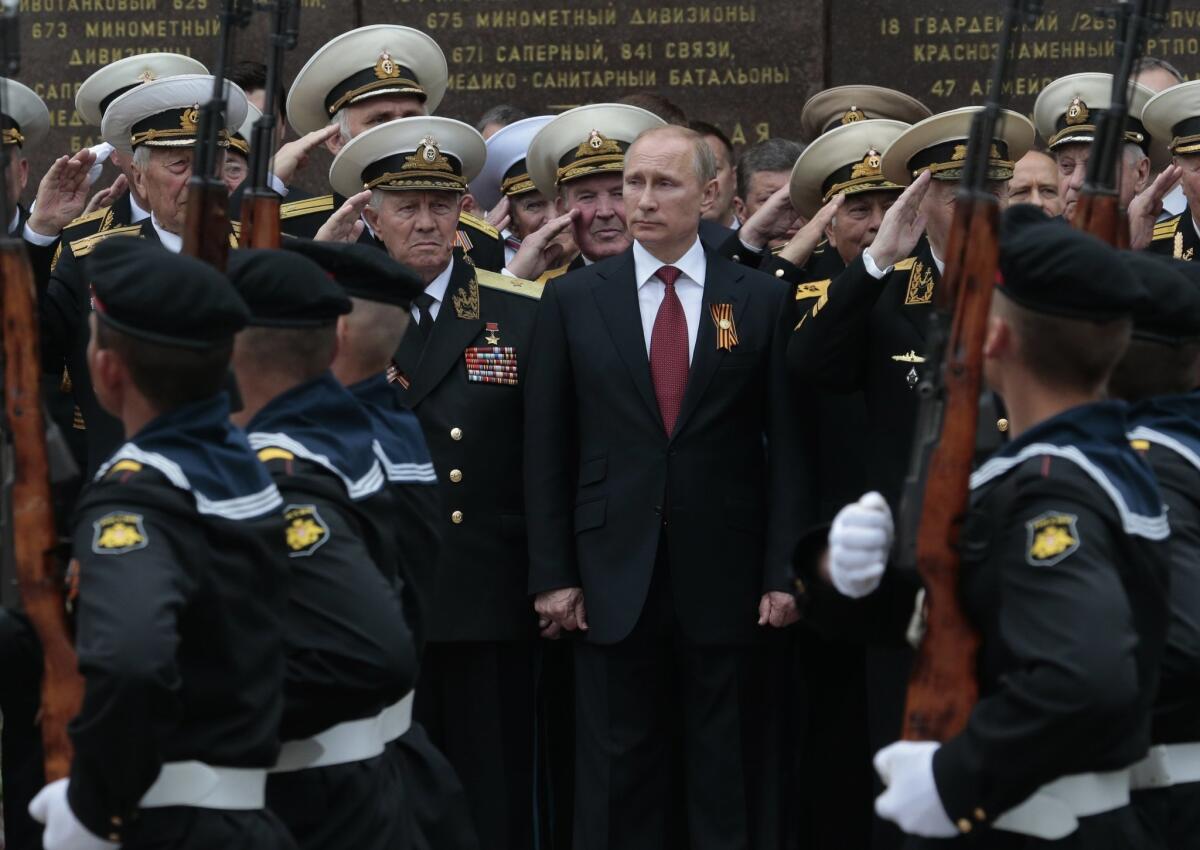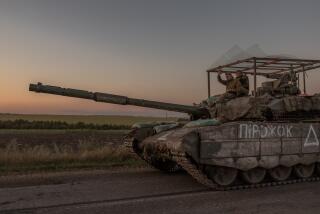In film, Putin justifies Russia’s seizure of Crimea last year

- Share via
Reporting from Moscow — Russia was prepared to activate its nuclear arsenal a year ago when its troops secured the Crimean peninsula and eventually annexed it to the Russian Federation, President Vladimir Putin said in a broadcast aired Sunday.
In the documentary-cum-reenactment, “Crimea: Path to the Motherland,” timed to Monday’s anniversary of a referendum in which Crimeans voted to secede from Ukraine, Putin justifies Moscow’s seizure of the Black Sea territory, saying it was necessary to protect Russians and military bases from what he described as a nationalist junta that had taken power in Kiev.
Putin accused the United States of masterminding the three-month uprising in the Ukrainian capital that ended with the ouster of Kremlin-allied President Viktor Yanukovich, who has since taken refuge in Russia. He said the “beneficiaries of the armed coup” planned to kill Yanukovich, prompting Putin to personally order Russian military intervention to protect the political ally and save Crimea from attack by Ukrainian nationalists.
Although the documentary was clearly prerecorded, it served to project a vibrant and defiant image of the Russian president, who hasn’t been seen in public for more than a week, spurring rumors that he is sick or has been deposed in a palace coup.
The Kremlin website on Sunday also carried a message of condolence from Putin on the death of Russian writer Valentin Rasputin, adding to the impression that he is on top of state affairs.
The documentary covered the year since the March 16, 2014, referendum in which 97% of voters among Crimea’s 2 million residents were said to have supported secession. Two days later, Putin issued a decree annexing the peninsula, which is home to Russia’s Black Sea fleet and Soviet-era air bases.
The film was a montage of images of Russian paratroopers coming to the rescue of Crimeans, Putin’s observations on his obligation to protect Russians outside his country and reenacted clashes between Ukrainian nationalists and the police and security forces defeated by the popular uprising in Kiev.
Masked Ukrainian zealots were depicted in the reenacted segments hunting Russians with attack dogs and barbed-wire-wrapped truncheons. Fiery scenes of torched police vehicles and black-clad rightists attacking law enforcement cast the overthrow of Yanukovich as a violent, Western-inspired coup d’etat, and the Russian minority in Crimea and eastern Ukraine as the targets of fascist death squads.
The United States, along with Poland and Lithuania, “facilitated the armed coup” by training the nationalists, Putin said.
U.S. and European officials have denied any role in the Ukrainian uprising against Yanukovich, who sought to scuttle a free-trade agreement between Kiev and the European Union that would have undermined Moscow’s influence in Ukraine.
Western sanctions against Russia over the Crimea land grab have compounded the economic blow of falling oil prices, plunging the country into an economic crisis.
Part of the operation to secure Crimea from the unrest that led to and followed the ouster of Yanukovich on Feb. 21, 2014, included the deployment of K-300P Bastion-P coastal defense missiles to demonstrate Russia’s willingness to protect the peninsula from military attack, Putin said in the 2 1/2-hour film aired on Rossiya-1 television.
“We deployed them in a way that made them clearly visible from space,” Putin said of the missiles and the message they sent to what he cast as Kiev’s Western taskmasters.
He also said the Russian military had been prepared to put nuclear weapons on alert if necessary, the latest in a battery of threats to deploy the nuclear option to counter what he suggests is a U.S. plot to dominate Russia.
Scenes of children chasing pigeons in Simferopol’s central square and the airport security chief reflecting on the tense moments a year ago as he gazes over vineyards from a bench with his young son convey a sense of Crimea having escaped the chaos gripping eastern Ukraine as pro-Russia separatists fight Ukrainian government forces.
Putin said he ordered the Crimean operation to protect the Russian community there.
“We cannot let the people be pushed under the steamroller of the nationalists,” he said of the decision made immediately after Yanukovich fled Kiev.
But he insisted that Russia first conducted an “emergency public opinion poll” to ascertain what the people of Crimea wanted in the way of a relationship with the new government in Kiev. He said 75% of those asked before the referendum expressed the desire to be reunited with Russia.
“Our goal was not to take Crimea by annexing it. Our final goal was to allow the people to express their wishes on how they want to live,” Putin said.
Crimea was conquered by czarist Russia in the late 18th century and remained part of the Russian Federation after the Bolshevik Revolution of 1917. But in 1954, Soviet leader Nikita S. Khrushchev, who was born in a predominantly Ukrainian village near the Russian-Ukrainian border, ceded the peninsula to the Ukrainian Soviet Socialist Republic. At the time, the gesture had little strategic significance, because the two republics had common armed forces and were within the same country.
Crimea became part of independent Ukraine after the 1991 breakup of the Soviet Union, a fact that has grated on Russian nationalists since.
Putin’s annexation of Crimea has been met with euphoric support in Russia, where state-run media coverage casts the Ukrainian political and security conflicts as the work of anti-Russia fascists and U.S. and Western European backers.
Follow @cjwilliamslat for the latest international news 24/7
More to Read
Sign up for Essential California
The most important California stories and recommendations in your inbox every morning.
You may occasionally receive promotional content from the Los Angeles Times.











